As the cold finally kicks in across southern Australia, minds turn to warmth versus wallet.
Staying warm doesn’t mean bankrolling your electricity retailer. Applying a few helpful hacks and habits can make a real tangible difference.
I have spent 15 years evangelising electrically; the good news is solar is cheap and smart arse comments are free, but the tradies who make them aren’t.
The bulk of the builders I’ve met aren’t horrible people, but they operate inside an industry that’s horribly powerful, expensive and cocksure; right up until you ask for something they’re unfamiliar with, like energy efficiency.
At that point, builders are highly resistant to change, because “nah mate” is the easiest answer when you’re not the sharpest tool in the trailer. And if saying NO doesn’t work, they’ll happily refer you to management, who apply “the d!ckhead tax” to price what you want out of existence.
Happily, that means we’re starting from a low base, so significant improvements aren’t hard to make — and if you’re a solar system owner, a well-insulated home means you can better retain the heat from electric heating powered by your panels during the day.
Where To Begin
I’ll be documenting some home improvements in the coming weeks because my house is a diabolically bad example.
If you want real comfort then I highly recommend gutting your home, insulating, replacing the roof, installing bulk solar and buying a new heat pump, because I’m great at spending other people’s money.
Of course, that’s not as sexy or immediate as buying a solar battery. Nor is it cheap and easy, because you’ll have to both deal with builders and somehow invent a double glazing industry that barely exists in Australia.
All Houses Are Different
Even identical houses have different owner expectations so we aren’t spelling out a recipe, but rather hatching some ideas you can use or adapt, and hopefully identifying some pitfalls to avoid.
I’m partial to old houses with ceiling height, but unlike a lot of aged housing stock locally, this cottage doesn’t have 300mm thick solid stone walls for thermal mass.
Rather, I have weatherboards, sagging stumps under a timber floor, chimneys, sash windows and a lack of insulation.
I can’t afford the expense to make it all perfect, but I’ve lived here long enough to know where it needs most attention, and hopefully you’ll see similar low-hanging fruit you can pick yourself.
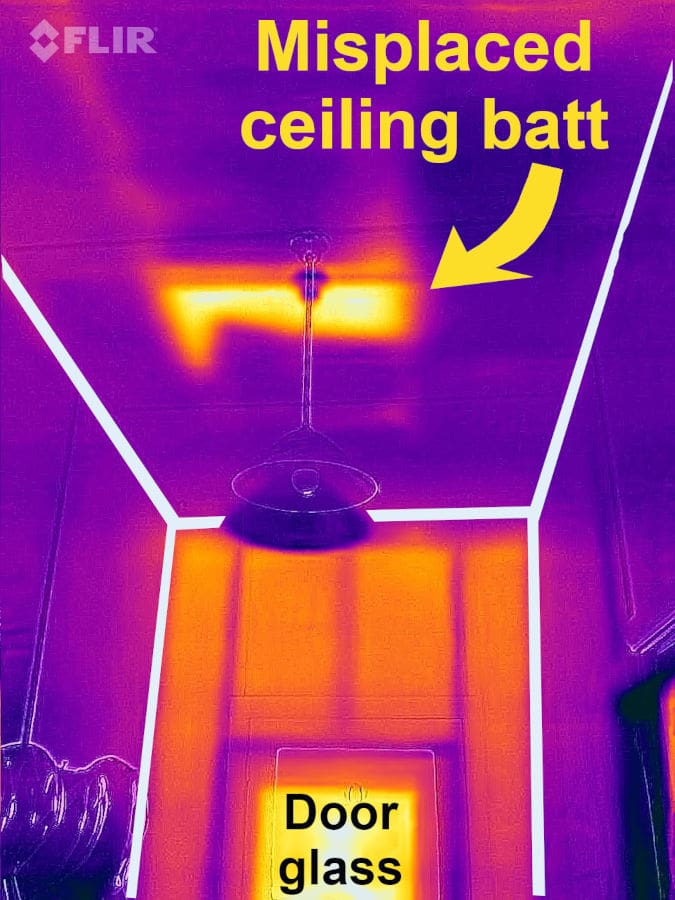
I’ve added white lines for clarity, but this hallway clearly shows the front wall around the door isn’t insulated, and the roof possums need to refit a ceiling batt.
1. Close The Bloody Door
You wouldn’t leave a window open in July, but if your doors and windows are leaking air, you basically are. 1
However plugging drafts can cut your heating bills by up to 25%. That’s huge.
There are many sites offering advice (Green It Yourself is a great option). In many instances, it’s just some time, foam tape, and maybe some door snakes.
One heads-up: Fixing your kitchen rangehood and bathroom exhausts can be an easy first win.
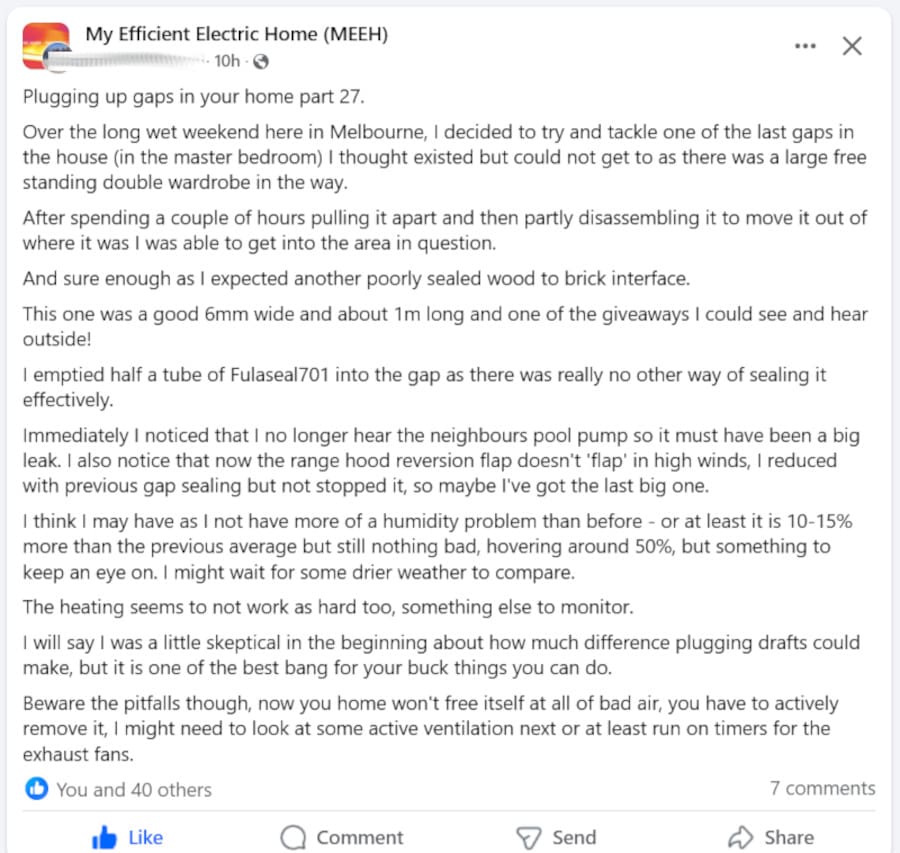
Gap sealing can be a battle but it’s one worth fighting.
2. Heat The Human, Not The House
If you’re working solo from home, don’t bother heating the whole place. Electric throws, heated desk pads, and good socks are your friends. Same at bedtime — a heated blanket is far cheaper to run than blasting the split system all night.
Just bear in mind that while the Nordics leave their babies outside in the snow, really low temperatures can be hard on your health if you’re somewhat asthmatic like me.
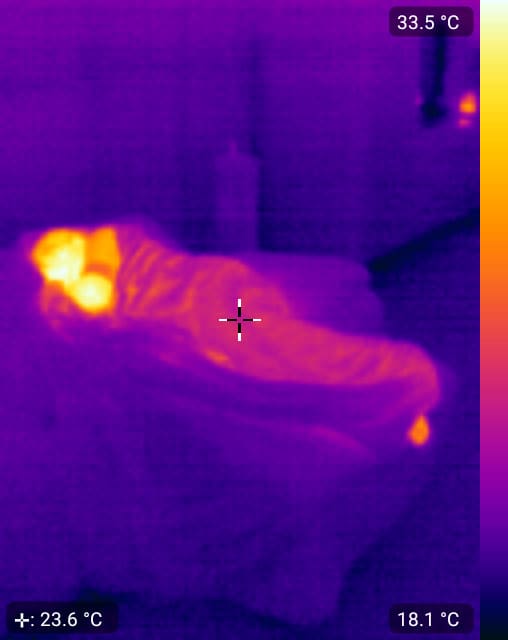
Laying bolt still in the dark this human gave the thermal camera operator a scare.
3. Insulate Your Windows
Seriously, this is so important that it will become several articles. When Australian builders worked out that glass is cheaper than bricks, our windows grew to be far too big, and we were sold a lie that this is just great!
A single-glazed, three-millimeter deep pane of glass can lose from 10 to 15 times more heat than an uninsulated wall of the same area.
Making windows excellent is expensive, but improving them dramatically isn’t hard.
-
Thick curtains or blinds: They need to fit snugly. Even better, add a pelmet up top to stop warm air from slipping away.
- Cellular or honeycomb blinds: These aren’t cheap but they’re well suited to modern houses with square window reveals. They’re available as translucent or light-blocking and they’re easy to automate, which is a boon for keeping temperatures under control without having to think about it.
-
Window insulator kits: Think of them as cheap and cheerful double glazing. Using thin plastic, stretched tight with wrikles removed by a hair dryer, you can keep you valuable warm air away from the cold glass.
-
Bubble glazing: Lets face it, some windows are best frosted anyway. Slap bubble wrap on with a spray of water for the worlds cheapest double glazing.
- Retrofit magnetic glazing: Once the materials arrive I’m going to show how to both draftproof and double glaze for heat and noise with a single pane of perspex.
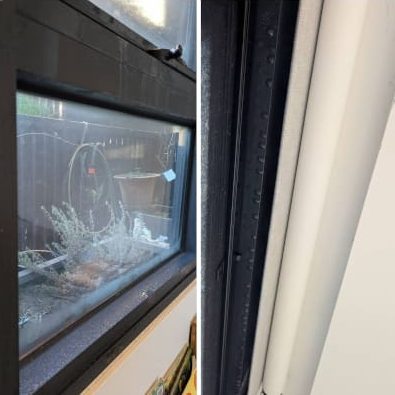
A photo from the Australian Passivhaus FB site showing condensation build-up even on double-glazed windows, because of the use of non-thermally broken aluminum window frames.
4. Beware Condensation
Too much condensation can lead to mould — it’s unhealthy and in extreme cases can cause structural damage.
-
Use the rangehood when cooking and the fan when showering.
-
If you dry laundry inside, make sure the room is ventilated.
-
Add insulation to cold walls and ceilings — condensation loves cold surfaces.
-
Use a dehumidifier. Even a small one can pull litres of moisture out of the air.
5. Hot Water Matters
Hot showers in winter feel great, but they’re costing you. If your water heater isn’t solar or a heat pump, it’s probably chewing through power. Swapping out showerheads for efficient ones is cheap, fast, and saves money every single day.
I’m A Builder, But Even I Battle With Tradies
Recently I had a plumber install a new bath in my house and I wanted it insulated, so it stays warmer for longer. Had I left him to it, he’d have refused.
So I hung around like a bad smell while he remonstrated with an argument that devolved from “nobody does” to “we can’t” to “our warranty won’t cover” so when pushed, he rang his boss who didn’t answer.
I offered to ring his boss only to be told “nah he’s busy and if he doesn’t answer me he won’t answer you”. Thankfully the stalemate was broken when the boss rang back. He was much more co-operative and told his worker to follow my lead as I showed them how to go about stuffing the bath cavity with pink batts.
It’s not rocket science but it’s bloody hard work dealing with trades who assume you’ll accept whatever they want.
And in the end the bath was still installed incorrectly, voiding the warranty… you wouldn’t read about it.
Making Blood Boil
The saddest part is the building industry is so short-sighted, crooked, just plain bent, that they’ve managed to corrupt the government into surrendering on energy.
In many parts of the country, including where I live in South Australia, the minimum energy standards for housing are now “frozen”2 because builders actively lobbied against progress. Their “win” means we all lose, because buildings don’t have to improve performance for the next ten years.
That’s a future of cheap rubbish houses that will forever cost more to run and be less comfortable to live in. So if you’re going to keep warm this winter in one of these homes, you’ll have to take matters into your own hands.
For more on cutting your bills during winter, read my explainers on how to improve the performance of reverse-cycle heating, and how to get off wasteful ducted gas.


 RSS - Posts
RSS - Posts


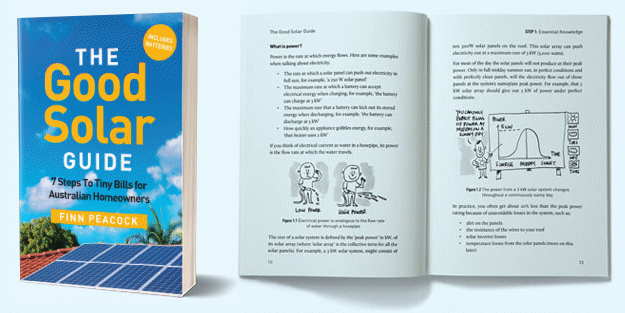
Ceiling insulation is very important, many homes only have R2 or 3 pink batts in their ceiling. Rip them out and insulate to R5 or better.
I had my R2 pink batts ripped out and replaced with Woolcell. It’s a mixture of wool and paper fibre. It covers every nook and cranny. The difference was noticeable the first night, the reverse cycle AC did not work as hard and the house was more comfortable.
I bet I save electricity as well.
There are other products as well, look at rockwool batts.
Oh and my windows are double glazed as well, got that done 7 years ago after I bought the house. I had them fitted without getting new frames so saved some costs.
I had woolbats. Australian Carpet Beetles ate 80% of the insulation after the treatment was no longer effective, approx 7 years. Had to have the roofspace pest treated twice and bin the remaining bats (fitted in one 240L bin) then vacuum clean the massacre of dead beetles. I decided not to call on the warranty as I would need to repeat this process in the future. They also love celulose.
Woolcell has some salt added to it to keep the vermin away.
I’ve done most of the things listed here, fixing windows, doors, plugging gaps etc. & it barely seems to make any difference so I figure it must be the insulation. This is Melbourne. The walls facing outside are freezing to touch and the laundry & toilet almost match the outside temperature so something dodgy is going on. To be fair the house is big and 50+ years old. And very (relatively) cheap to rent so that makes up a bit for the stellar energy bills. Next time I’ll rent a brick apartment on the second floor.
One of the biggest wins for us was covering up the old wall vents after we jettisoned the oil fire.
I have double and triple ‘glazed’ some of our glass using optical grade acrylic cut to size by the plastic company. We have a glass entry door like the one pictured. The reduction in outside noise was incredible.
I think keeping our external roller shutters on the Western side closed helps too. We also only heat the living end. No need to heat bedrooms. And SWMBO loves her heated throw.
If “a single-glazed, three-millimeter deep pane of glass can lose from 10 to 15 times more heat than an uninsulated wall of the same area” then how do double or triple glazed windows compare?
Oh course this ignores the fact builders don’t know the difference and according to the glass experts they’re all the same – well maybe not triple glazed, but can you get that in Australia?
Not directly mentioned in this piece is that for cold nights, or cyclone season, external roller blinds can help – assuming they’re built right, and your window or glass door\wall sections aren’t too large.
George, coincidentally I’m looking into this now. Our new house is about to be built in Northeast Victoria and although we’re getting double glazing throughout, there is more to be gained.
Here’s a good resource to start with.
https://www.yourhome.gov.au/passive-design/glazing
My wife and I always chuckle at the ads for revolutionary bits of glass to put in your windows to make instant ‘double glazing’.
Those ads remind us of growing up in Europe in the seventies and eighties.
I liken house air leakage to wearing the best jacket to keep you warm but not zipping up the zip. While reverse cycle air conditioners are economical for sure,..they only heat the air, which easily escapes through gaps, and the bigger the house the faster it goes.
clearly our biggest gaps are into the ceiling space through exhausts fans, with other gaps to allow the hot air to be replaced with cold as it rises.
We really should have automatic flaps on all roof vents and seal all ceiling/wall joints before we chase the other hidden leaks,… and hang a blanket over the larger windows (tucked in at the top) for a quick fix.
Anthony, only issue I have with what you have written is that you were far too complimentary to builders and trades , particularly those working on new builds as subcontractors.
Recent new build was the first time I have seen a compliance certificate. It amazed me that they are prepared to produce compliance certificates for what they have done or often not done. Insulation was one of these areas.
Crawling the roof to replace batts sparkies or AC installers have chucked is first on my list of what you need to do. Check they insulated any light well for skylights as well. Raked ceilings and walls with a half arsed effort to insulate are rather harder to fix.
You mention thermal breaks in window frames. Seems the crap put in here wouldn’t be tolerated OS.
Until the Building industry, where we make the most substantial investment of our lives, is held accountable to the same level of consumer protection as the purchase of a hairdryer they will continue to rip off and gaslight consumers.
I have to agree with your AC installer reference.
I have had some spare time over the past 5mths, so I bought myself a thermal camera for my phone and obsessively started looking at the insulation placement in our ceiling.
I installed it about 15yrs ago and thought I had done a good job. A couple of years later, we had ducted air installed and kids came along, so no time to get back in the roof and check it. Now I can see the “damage” that the AC installers had done to the insulation, moving batts around and so on. I could also see issues with my own insulation installation. So with my spare time, I’ve been able to fix up both issues. The thermal images look better now with a consistent temperature across the ceiling. Now I know I have done a good job, but there’s no way the average insulation installer is going spend time plugging up small gaps between beams or ensuring every batt is flat against the ceiling unless you’re constantly on their back obsessively checking their work.
Yeah, I’ve read about sealing your house and thought it was great idea. Until I, unfortunately, got a CO2 monitor as part of a weather station. I dutifully removed all sources of drafts from our bedroom and then watched as CO2 levels in the bedroom passed 2000 ppm before midnight. Which according to the literature is approaching dangerous levels.We ended up cracking a window open for fresh air. Am now reluctant to seal rest of house and treat the drafts as necessary ventilation.
Moral of this story = don’t ever buy a CO2 monitor.
Hi Tony,
Ignorance is bliss isnt it.
I think the outright best arrangement is a well sealed building with heat recovery & ventilation.
HRV runs 24/7 sucking moisture & smells from bath/kitchen/laundry. The warmth/coolth is exchanged to fresh filtered air which is introduced to living areas & bedrooms.
Biggest issue is that the system, including all the ducts, really wants to be inside the house, so retrofitting is difficult unless perhaps you can lower the ceiling down the length of your hallway..?
Thanks Anthony. Alas we have raked ceilings throughout with no roof cavity (& no hall). We have bathroom exhausts at each end of house that work well in mild heat and cool, but not in freezes or heatwaves, when we have to isolate living areas in house. Fortunately we have pelmetted (if that’s a word) heavy drapes in virtually all rooms that work reasonably well.
Am looking for long term solution, but in mean time put up with small drafts and tell visitors they are cleverly designed ventilation that I installed to safeguard their health 😂.
I think that energy recovery ventilators are required by building code in Canada.
And airtightness is pretty much required for comfort. Before poly and Tyvek were common, they’d use a lot of tarpaper under the siding.
Studies by Harold Orr with the Saskatchewan Research Council proved that airtightness is important.
British Columbia’s “Leaky Condo Crisis” later proved that heat exchanger ventilation and humidity control were important as well. Some had to be demolished as the rot had gone beyond repairable.
Anthony, in my first OB, 35 y.a., I shared your yen for high ceilings, designing a 5m cathedral lounge ceiling – with clerestory windows to boot. That single-glazed edifice was a winter nightmare. Burning 8 – 10 tonnes of firewood p.a. did not make it warm, despite big ceiling fans. At least no net CO₂.
The second, with 2.7m ceilings, double glazing, and ample insulation, has just reached 27°C with 800 W into the RCAC, and some winter sun at 38° S. Honeycomb blinds considered, but not needed yet.
An OB now needs to gain a “white card”, but that obviates any complaint when you install all the wall and ceiling batts yourself. Being the builder, and having drawn the approved plans, adds leverage when instructing contractors, and makes the cost of any unusual requirement subject to competitive quotes.
Be OCD. Checking the plumber’s placement of sink drain, prior to slab pour, showed the cupboard door wouldn’t close = 50 cm off. Friendly call -> immediate fix. Teamwork conquers all.
It should be mandatory that Builders must pass a Blower Door Test on new builds. A Blower door blows or sucks to 50 pascals (equiv 30Kph wind), & the Air flow can be used to calculate the building Air Changes per Hour. Passive Houses leak less than 0.6ACH, but the average US house passes less than 3ACH. Australian houses typically are between 7>15ACH. The problem with air leaks is condensation in the insulation (=Mould).
When a house is well sealed, it is fitted with an Air Exchange system (MVHR), that exchanges air (& heat or cold) efficiently (60>80watt draw). Air taken from Kitchen Bathrooms, & introduced to living & bedrooms. Flushes CO2 & pollutants, as well as being filtered air (reducing cleaning!).
Note: Insulation must have no gaps 10% gaps cause 30% losses.
For more information, google ´PassivHaus’. These are being built in Aust, at about 15% price penalty, but huge savings in Bld running costs. Old buildings can be retrofitted: even Weatherboard houses!
This is Canada’s recommended, voluntary standard:
https://natural-resources.canada.ca/energy-efficiency/home-energy-efficiency/details-r-2000-standard
Our 18 year old house tested 1.6 air changes per hour in a blower door test. It has about R20 in the walls and R30 in the attic.
The majority of heat loss is through the double pane windows, they are not ‘low-E’. They ice over completely at night when we close the blinds.
Nearly all houses here are dug into the ground a couple metres, and the water lines are buried at least two metres down to prevent freezing.
But it’s summer here, so highs of 11 to 14 and lows of 4 to 5 C for this weekend, and rain that we desperately need.
I lived in Canada for 11 years, came back to Australia 10 years ago. In Canada it was always 23 degrees inside, 24/7, all year round. We set the thermostat and forgot it. Had to go out side to see if it was hot or cold.
The houses were warm and comfy. How I miss that here back in NW Sydney Australia. We freeze our butts off here. We were warmer in Canada, despite snow banks in our driveway in winter nearly 2 metres high sometimes. We lived near Toronto.
So anyway, Australia really must improve building standards, have at least double glazed windows, an air tightness standard, heat exchange units for fresh air ventilation, better roof and wall insulation etc.
Yes, building to those standards will work to keep heat out as well as in. And a heat exchanger keeps the energy cost down. We were putting them in hog barns 20 years before they became common in houses.
We used to rely on the basement as a refuge from 36 C summer evenings in the years before air conditioning. Or a beach.
Timothy, Australia is improving, albeit slowly, probably because the climate is lenient. When I built, several years ago, the “6 stars” prescription required double glazing, substantial insulation, and a raft of other measures. Ceiling fans won one star, for example. Solar didn’t count, but “e-coated ” window glass did. I forget whether a water tank was sufficiently fashionable to count.
There has been talk of requiring “7 stars” soon, so further improvement is doubtless imminent. I’ve stopped reading NCC mail-outs, as I’ve built my last house, snug enough to last me. It’s toasty warm, here in midwinter, with just 500 W going into the RCAC, the wood fire set, but not lit, as it’s not needed.
Architecting the plans and owner-building avoided builder’s penny pinching minimisation of features. High cost & workforce strictures must make it a nightmare for non-technical young buyers. Much polly-waffle & red tape, minimal real optimisation. DIY for best motivated effort, I figure.
One area that lets drafts in is around the dishwasher. Typically the installers rip the skirting boards out leaving a massive gap between wooden floors and the wall that lets the wind in if your subfloor has good ventilation. The cabinets are typically offset from the walls at the back and while they have kickboards to somewhat seal them this doesn’t usually extend to the dishwasher area which has gaps all around it.
Open staircases also lead to problems heating downstairs. We actually had our kids cooling upstairs while we were trying to heat downstairs in winter.
A really wide roller blind did the job here across the alcove to the stairs.
House is circa 1918, so I’ll be retrofitting a second glass pane in front of the leadlight windows with some nifty woodwork.
but, but I live in Queensland, of course all my windows are open in July…
In 1976, we built a brick veneer home in SA, I insulated the walls outside with R1.5 batts, Even the guy that sold them to me said I was crazy. We insulated the ceiling later.
In 2003 we built another house and the builder had allowed for wall insulation and R3.5 in the ceiling, I paid and extra $500 for R4.5 in the ceiling.
When I looked in the roof space, they had piled the excess insulation in a corner. I carefully moved it to the area over the garage that hadn’t been insulated, concentrating along the walls adjacent to the inside walls of the house.
1970’s houses in Canada were usually wood frame with R8 between the 3.5″ wide studs, and double pane windows, and R-12 above the ceiling.
Now they would put at least 4.5″ of insulation in the walls and R-30 to R-50 in the attic, but still using double-pane glass unless you upgrade.
We see about 5,500 to 6,000 heating degree-days and 300 to 500 cooling degree-days annually. It’s the middle of summer and the forecast low temp for this coming Sunday is 4 degrees C. We’ll stay warm by closing the windows.
Don’t forget that to compare North American insulation R values to Australian, you must divide the US values by 6, approximately.
Yes, sorry, the great thing about standards is that there are so many. Yes, 1 RSI is 5.678 R units in the Imperial system
We supposedly converted to ‘metric’ units in the 1970’s, but there’s a lot of trade, so we get 454 gram packages and 0.946 ml containers, the wall studs are 141 mm wide, and the old BTU R-value is what buildera still use.
So an attic om a new build here would be insulated to about RSI 8.
Here in New Zealand we have a product called shower dome, fitted over an enclosed shower it keeps the steam in your shower and reduces steam and condensation in the bathroom to virtually zero. In my recent bathroom renno I removed the ceiling extractor fan and replaced with one in the wall. Fitted a shower dome, new ceiling and insulation, double glazed window, the fan is barely ever used and the bathroom feels great to be in, never cold or damp. The only complaint I have heard about shower domes is it gets dusty – my reply is I prefer dusty to mouldy.
Available in Aus as well. Might even be an Australian product.
SWMBO is worried about mould inside the shower cubicle. I might try a flat piece of optical grade acrylic first.
Showerdome is a NZ company, Bunnings in NZ sells a product called Turtle Shell. Showering is a lot warmer as the heat is trapped inside. Generally a lower water temperature is more comfortable and as the air is warmer in the shower it is not steamy. It is only when you open the door to get out and the warm moist air hits the colder air you will see a small puff of steam. As it’s a new glass shower enclosure we squeegee the glass dry to keep it perfect, I believe this also helps keep the bathroom dryer as the water goes down the waste in stead of evaporating.
It’s like this article read my mind. We are currently building our house in Hervey Bay, QLD and we had to force the builder to put insulation into our internal walls. Every thing with the builder seems to be an effort and they just seem to come up with excuses as to why we don’t need it. Thanks for this articles. It all makes sense now.
Having grown up in Denmark with one of my first childhood memories from the mid 70’ies after the oil crisis was seeing how the double brick cavity in our house was insulated with blow-in rockwool (after windows were replaced with double glazing with inert gas in cavity) I am puzzled that is not more popular in Australia (at least in SA/VIC). I have a double brick myself here in SA and would love to DIY which would be easy by removing roof tiles around the edge (no sarking – don’t get me started) or perhaps get someone to do it. When our windows was installed 10 years ago I watched in horror how the tradies left 50 mm gaps around the edge and just put flashing on to cover.
Where can I purchase a heat detector similar to the one shown in the pictures?
The one that was used in the article, was a unit made by a company called FLIR. These can be quite expensive, they have a range of models ranging from mobile phone units to stand alone units. They can be purchased online.
Before this article was released, I bought myself a small one from Amazon, that could connect to my mobile phone. It was not the FLIR brand, so was a lot cheaper. While it seems to be good quality, I doubt the temperature reading accuracy is as good as the FLIR brand. It displays pictures like the ones in this article, highlighting insulation problems in your roof and walls. I spent the first half of winter fixing small insulation gaps in my ceiling with it. It could find gaps looking up at the ceiling better than I could find the gap in the roof space, looking down at the insulation. Good news is, that I have fixed all the gaps that I can get to. Bad news is that there are more gaps that I can’t get to without removing tiles on my roof.
Amazon.com.au has a few
What is the name of it?
The one that I bought was an “InfiRay P2 Pro Thermal Camera for Android”.
I think there is also an iPhone version, but whatever you buy, make sure it matches your phone.
This is only one brand and model that is available. Look around Amazon and elsewhere for “Thermal cameras” and you will find lots more to choose from. Like I said in an earlier post, you can get ones that plug into your phone like this one, or you can get stand alone handheld ones.
Think about what you are going to use it for and how long you plan to use it and then decide how much you are going to spend. After fixing my ceiling insulation, I don’t have much to use mine for at the moment, but a friend of mine would like to borrow it and if/when we move house or we do any renovations to our current house, I’d certainly use it again.
GJ
I use a FLIR branded unit which is simply a phone attachment… some years ago it was $600.
Roughly speaking, the more you spend, the better the resolution gets.
It may also be worth investigating an industrial hire shop or your local library for an energy audit kit.